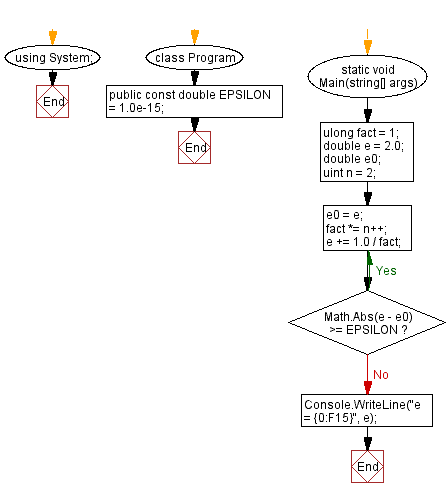C#: Calculate the value of e (Euler's number)
Calculate Euler's Number (e)
From Wikipedia,
The number e, also known as Euler's number, is a mathematical constant approximately equal to 2.71828 which can be characterized in many ways. It is the base of the natural logarithms. It is the limit of (1 + 1/n)n as n approaches infinity, an expression that arises in the study of compound interest. It can also be calculated as the sum of the infinite series

Write a C# Sharp program to calculate the value of e.
Note: e is also known as Euler's number and Napier's constant.
Sample Solution:
C# Sharp Code:
using System;
namespace exercises
{
class Program
{
// Constant to define a very small value for comparison
public const double EPSILON = 1.0e-15;
static void Main(string[] args)
{
// Initialize variables
ulong fact = 1; // Initialize factorial value to 1
double e = 2.0; // Initialize the value of 'e' to 2.0
double e0; // Initialize a temporary variable to hold previous 'e' value
uint n = 2; // Initialize a counter 'n' starting from 2
// Loop to calculate 'e' using a series approximation until the difference between successive 'e' values is less than EPSILON
do
{
e0 = e; // Store the current value of 'e' in 'e0'
fact *= n++; // Calculate the factorial incrementally and update 'n'
e += 1.0 / fact; // Update 'e' using the factorial value
} while (Math.Abs(e - e0) >= EPSILON); // Continue the loop until the difference between current 'e' and previous 'e' is greater than or equal to EPSILON
// Output the calculated value of 'e' with high precision
Console.WriteLine("e = {0:F15}", e);
}
}
}
Sample Output:
e = 2.718281828459050
Flowchart:

For more Practice: Solve these Related Problems:
- Write a C# program to calculate the value of e using factorials up to the 20th term.
- Write a C# program to estimate Euler’s number with an error less than 0.0001 using a loop.
- Write a C# program to approximate 'e' using infinite series until the difference between terms is negligible.
- Write a C# program to calculate e raised to the power of x using Taylor Series expansion.
Go to:
PREV : Equality of Value and Type.
Next C# Sharp Exercise: Create Identity Matrix.
C# Sharp Code Editor:
What is the difficulty level of this exercise?
